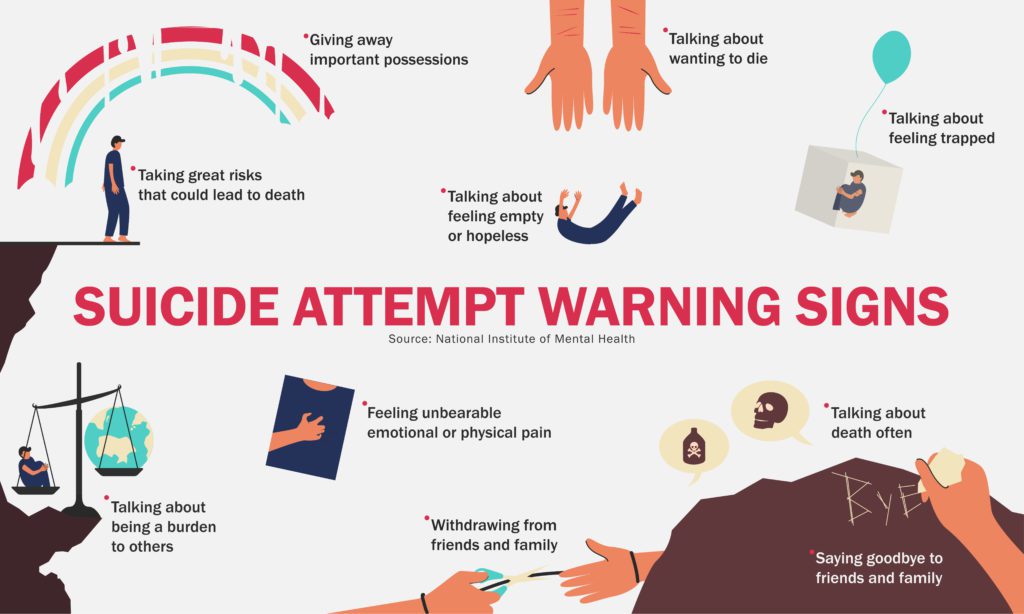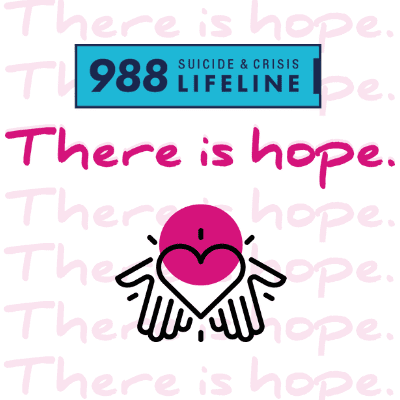
This blog post was written by Lauren Rick, MSW, APSW, a behavioral health therapist at the Beloit Area Community Health Center.
Naomi Judd. Chelsea Crist. Zoe Sozo Bell. Ian Alexander. Anthony Bourdain. Chris Cornell. Robin Williams. They, along with so many other individuals, succumbed to their suicidal thoughts. Suicidal ideation is very prevalent in American society. In 2020, over 12 MILLION United States adults had serious thoughts of suicide. Of youth and young adults (aged 12-17) 3 MILLION had serious thoughts of suicide. (NAMI, Mental Health by the Numbers, 2022)
Many people have heard of or have repeated a quote by Phil Donahue: “Suicide is a permanent solution to a temporary problem.” However, many people who think about suicide view the quote very differently. Some feel, “Yes, that is what I want. A permanent solution. Almost like encouraging me to do it.” A few recent research studies suggest that there is a short frame of time between the first current thought of suicide and the actual attempt had lasted 10 minutes or less. (Deisenhammer, E. A., 2009).
Why do people commit suicide? There are so many reasons, but these are the main categories: Depression, psychosis, impulsivity, crying out for help, philosophical reason to die-such as experiencing a terminal illness, to shorten the dying process that will happen regardless.
Many times, when someone commits suicide, the family does not admit or discusses the cause of death. There are myriad reasons for this: The shame and stigma for the family in that maybe it would reflect on themselves or poorly on the home, suggesting family problems or disease. Many religions discourage suicide and have embedded the taboo of suicide into the culture. There is also the fear that we experience ourselves, perhaps if we talk about it too much, we will discover some uncertainty within.
When someone survives a suicide attempt, many of them feel the stigma that can follow them the rest of their life. Some report that their family and friends treat them differently, even if their mental health is stable. Some will experience stigma within the community that they live, shunned by some of their neighbors and friends.
There is hope. The conversations are beginning. More families are more forthcoming about how a loved one died from suicide. Public figures are opening up about mental illness and suicide. Survivors of suicide attempts are speaking out, realizing that they are an important part of the conversation. There is a movement wherein people who have survived a suicide attempt or are living with suicidal ideation are getting a tattoo of a semicolon. It is symbolic of the fact that there may have been a time when the person experienced or is experiencing suicidal ideation. It is a symbol of struggle, survival, and victory.
Suicide prevention week, held annually in September, is a week-long campaign in the United States to inform and engage health professionals and the public about suicide prevention and the warning signs of suicide.
What are the warning signs of suicide?
- Talking about wanting to die or kill oneself
- Looking for a way to kill oneself
- Talking about feeling hopeless or having no purpose
- Talking about feeling trapped or being in unbearable pain
- Talking about being a burden to others

Five steps on how to help someone who is thinking about suicide:
Ask the question “Are you thinking about suicide?” You can include “How do you hurt?” and “How can I help?” Do not ever promise to keep their thoughts of suicide a secret. Asking will not increase the likelihood of the person committing suicide or their suicidal thoughts.
Be there for them. Be physically present, in person, on the phone, or any other way you can support them. Do not commit to anything you are not willing or able to accomplish. Most importantly, listen. Listening will help you to figure out what and who they believe will be the most effective sources of help.
Help to keep them safe. Try to find out a few things to establish immediate safety. Have they already done anything to try to kill themselves before talking to you? Do they have an idea or a plan of how they would do it? What is the timing? Do they have access to the things they would need to carry out the plan, such as firearms, medication, etc? If the timing is imminent, then calling for emergency help or driving them to an emergency department may be necessary. If you are unsure how to assist them, dial 988 to get support and guidance. Make sure the person you are assisting has this number. It is the National Suicide Prevention Hotline, and it’s available 24 hours a day, seven days a week, to provide help in crisis, suicidal ideation and sexual assault situations. It can also provide information on resources or even provide someone to listen.
Help them connect. Talk about the different resources for help, such as the 988 Lifeline, the Crisis Text line, the local county Crisis Line. Have they tried these? Have they sought therapy? What has worked? What hasn’t? Help them develop a safety plan-what to do, and who to call when they are experiencing significant thoughts of suicide. It should also include a list for people to call for support and assistance.
Follow up with them. Check in after your initial contact. Ask how they are doing. Leave messages, send texts. Is there anything else you can assist them with? Checking in helps them feel more connected with others and reduces the loneliness that can be a factor in suicidal ideation.(How the 5 Steps Can Help Someone Who Is Suicidal, 2022)
Take advantage of the information provided during suicide prevention week to increase your knowledge about this problem that affects so many of us or those we know and love. Be part of the solution by providing support to someone in a mental health crisis-you may just save a life.

Sources:
Deisenhammer, E. A., Ing, C. M., Strauss, R., Kemmler, G., Hinterhuber, H., & Weiss, E. M. (2009). The duration of the suicidal process: how much time is left for intervention between consideration and accomplishment of a suicide attempt?. The Journal of clinical psychiatry, 70(1), 19–24.
How The 5 Steps Can Help Someone Who is Suicidal. (2022, July 16). #BeThe1To. Retrieved September 7, 2022, from https://www.bethe1to.com/bethe1to-steps-evidence/
Mental health by the numbers. NAMI. (n.d.). Retrieved September 7, 2022, from https://www.nami.org/mhstats













